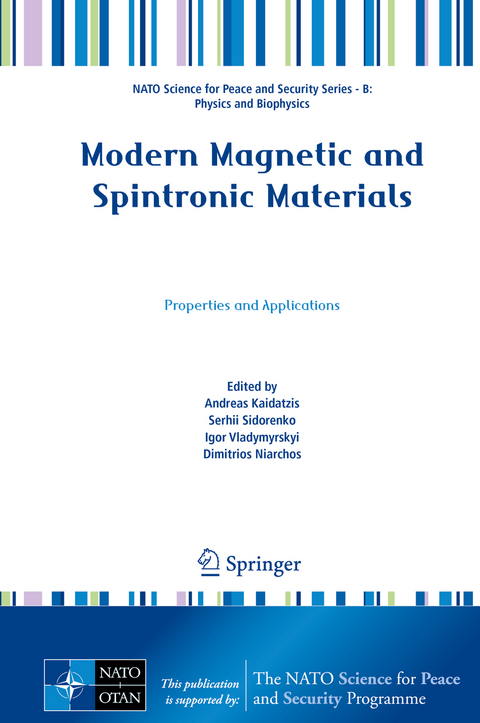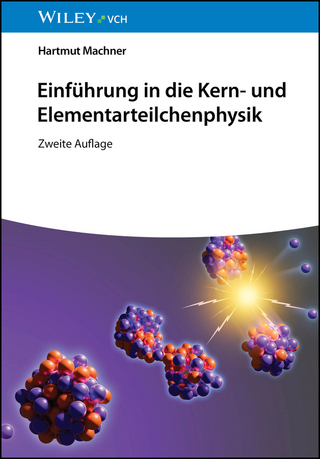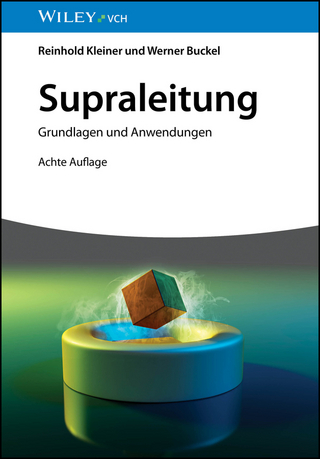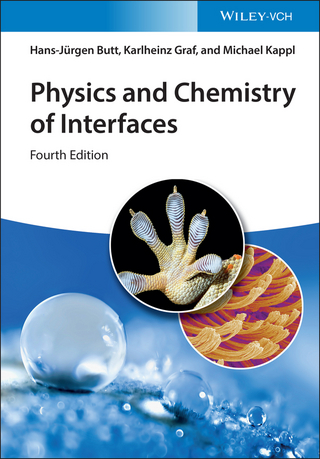
Modern Magnetic and Spintronic Materials
Springer (Verlag)
978-94-024-2033-3 (ISBN)
All of the above-mentioned applications rely on the properties of the materials used.
Magnetic and spintronic materials are ubiquitous in modern technological applications, e.g. in electric motors, power generators, sensors and actuators, not to mention information storage and processing. Medical technology has also greatly benefited from magnetic materials – especially magnetic nanoparticles – for therapy and diagnostics methods.
All of the above-mentioned applications rely on the properties of the materials used. These properties in turn depend on intrinsic and extrinsic material parameters. The former are related to the actual elements used and their properties, e.g. atomic magnetic moment and exchange interaction between atoms; the latter are related to the structural and microstructural properties of the materials used, e.g. their crystal structure, grain size, and grain boundary phases.
Focusing on state-of-the-art magnetic and spintronic materials, this book will introduce readers to a range of related topics in Physics and Materials Science. Phenomena and processes at the nanoscale are of particular importance in this context; accordingly, much of the book addresses such topics.
Dr. Andreas Kaidatzis, Institute of Nanoscience and Nanotechnology, National Centre for Scientific Research “Demokritos”, Athens, Greece e-mail: a.kaidatzis@inn.demokritos.gr Dr. Kaidatzis holds a first degree in Physics (2003) and a postgraduate degree in Materials Physics (2005), obtained from the Aristotle University of Thessaloniki, Greece and a doctoral degree in Solid State Physics obtained from the University of Paris 11 (2008) as a Marie-Curie Fellow. He has worked as postdoctoral Researcher at the Institute of Microelectronics of NCSR “Demokritos” (2010-2011) and at the Institute of Microelectronics of Madrid (2011-2013) in the framework of an Individual Marie-Curie Fellowship. His work was focused on the study of magnetic thin films and nanostructures using magnetic force microscopy. Since May 2013 he is working as a Research Associate at the Institute of Nanoscience and Nanotechnology of NCSR “Demokritos”, studying magnetic and spintronic materials formemories, data recording, sensors, and permanent magnets applications. Dr. Kaidatzis has participated in several international research projects, granted from the European Commission, the Spanish research council (CSIC), and the Hellenic General Secretariat for Research and Technology. He has published his work in 18 peer-reviewed journals and presented more than 50 abstracts in national and international conferences. Prof. Dr. Serhii Sidorenko, Metals Physics Department, National Technical University of Ukraine “Igor Sikorsky Kyiv Polytechnic Institute”, Kyiv, Ukraine e-mail: sidorenko@kpi.ua Prof. Dr. Sidorenko graduated from the Moscow Institute of Steel and Alloys (1971). In 1987 he defended his doctoral thesis. Research activities of Prof. Sidorenko are linked with advanced technologies on the basis of theoretical and experimental investigations of diffusion processes, phase formation and other phenomena in different metallic materials. He authored over 300 papers in area of physical materials science. Under his leadership, 24 PhD theses were defended. Dr. Igor Vladymyrskyi, Metals Physics Department, National Technical University of Ukraine “Igor Sikorsky Kyiv Polytechnic Institute”, Kyiv, Ukraine e-mail: vladymyrskyi@kpm.kpi.ua Dr. Vladymyrskyi is an Associate Professor of Metals Physics Department of National Technical University of Ukraine “Igor Sikorsky Kyiv Polytechnic Institute”. He received his PhD degree from the same University in 2014. Research interests of Dr. Vladymyrskyi focus on structural phase transitions in nanoscale metallic layered thin films, diffusion and diffusion-controlled phenomena in these materials, their structural, magnetic and electrical properties. Recent works are devoted to thermally-induced diffusion formation of ferromagnetic L10 ordered thin films – e.g. L10-FePt, L10-FePd, L10-MnAl – promising materials for applications as magnetic recording medium with ultrahigh recording density or ferromagnetic electrodes of spintronic devices with an excellent functionality. Dr. Vladymyrskyi has coauthored about 30 papers in international peer-reviewed journals. He is a co-leader of a joint with Augsburg University (Germany) project “Cold homogenization of Fe/Pt based layered thin films induced by diffusion processes” funded by German Research Foundation (DFG). Prof. Dr. Dimitrios Niarchos, Institute of Nanoscience and Nanotechnology, National Centre for Scientific Research “Demokritos”, Athens, Greece e-mail. d.niarchos@inn.demokritos.gr Prof. Dr. Niarchos obtained his B.Sc. and Ph.D. in Physics-Materials Science from National Kapodestrian University of Athens, Greece in 1972 and 1980 respectively. He holds also an MBA of R&D from Loyola University in 1985. From 1978 to 1981 he was IAEC Distinguish Post-Doctoral Researcher at Argonne National Lab and from 1981 to 1985he was Assistant Professor at the Illinois Institute of Technology, Chicago, USA. He then moved to the Institute of Materials Science of the NCSR “Demokritos” in 1985 as Senior Researcher. He was promoted to the Director of Research (Grade A) researcher in 1992. From 1994-1999 he served as the Director of Institute of Materials Science of the NCSR “Demokritos” and from 1996-1999 he was elected as Vice President of the NCSR “Demokritos”. From 2005-2010 he was elected as Director and President of the Board of the NCSR “Demokritos”. He is studying magnetic materials for novel permanent magnets, ultrahigh recording media, magnetic memories, and magnetic micro-nanolaminated structures for UHF DC-DC converters. He is the author and co-author of more than 490 publications with more than 8000 citations and has managed more than 35 National and EU projects with a budget of approximately 12 MEURO. He had served as advisor for the Greek Government, NATO and the EC. He holds 6 patents related tonanomaterials, thermoelectrics and high entropy alloys for permanent magnets.
Chapter 1: Detection of microwave and terahertz-frequency signals in spintronic nanostructures.-Chapter 2: Microwave characterization of Y3Fe5O12 ferrite under a dc-magnetic field.- Chapter 3: Nanopatterned thin films with perpendicular magnetic anisotropy – structure and magnetism.- Chapter 4: L10 ordered thin films for spintronic and permanent magnet applications.- Chapter 5: Effect of Au layers on A1→L10 phase transition and magnetic properties of FePt thin films.- Chapter 6: New applications of spin-crossover complexes: microwave absorption, chirooptical switching and enantioselective detection.- Chapter 7: Grain boundary diffusion dominated mixing and solid state reactions in magnetic thin films.
| Erscheinungsdatum | 30.07.2020 |
|---|---|
| Reihe/Serie | NATO Science for Peace and Security Series |
| Zusatzinfo | 83 Illustrations, color; 18 Illustrations, black and white; XII, 162 p. 101 illus., 83 illus. in color. |
| Verlagsort | Dordrecht |
| Sprache | englisch |
| Maße | 155 x 235 mm |
| Themenwelt | Naturwissenschaften ► Physik / Astronomie ► Atom- / Kern- / Molekularphysik |
| Naturwissenschaften ► Physik / Astronomie ► Elektrodynamik | |
| Naturwissenschaften ► Physik / Astronomie ► Quantenphysik | |
| Technik ► Maschinenbau | |
| Schlagworte | magnetic materials • Radio Frequency energy harvesting • spintronic detector • Spintronic Devices • spintronics for radar sensing |
| ISBN-10 | 94-024-2033-9 / 9402420339 |
| ISBN-13 | 978-94-024-2033-3 / 9789402420333 |
| Zustand | Neuware |
| Informationen gemäß Produktsicherheitsverordnung (GPSR) | |
| Haben Sie eine Frage zum Produkt? |
aus dem Bereich


